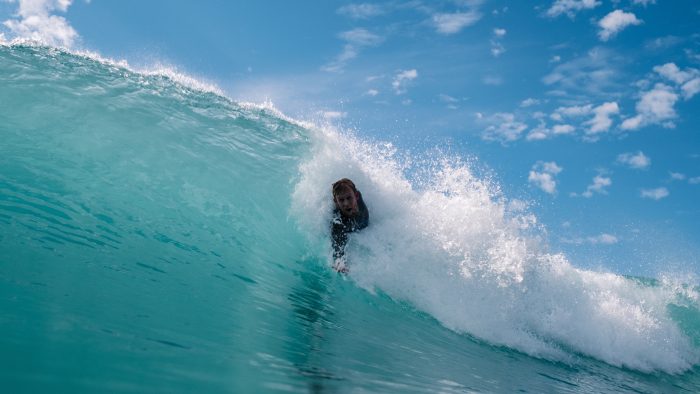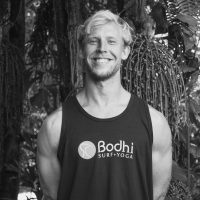I recently watched a 14-minute Youtube video that convinced me that bodysurfing—the art of riding waves with one’s body—is essentially an aquatic form of yoga.
Bodysurfers, like yogis, are masters of body and breath control.
Any experienced bodysurfer reading this will recognize the importance of applying the following four yoga techniques when gliding across the face of a wave:
- Asana—mastery of body posture
- Mudra—mastery of hand position
- Pranayama—mastery of breath control
- Dhyan—mastery of concentration
Asana
To catch a breaking wave, the bodysurfer must position her body just right. She must also maintain a perfect balance of rigidness and buoyancy to ride the wave as long as possible. This mastery of body positioning and control is known as Asana.
Mudra
Once she has caught the wave, the bodysurfer extends her lead arm out in front of her, applying pressure on the surface of the water with her hand to trim along the wave face. This mastery of hand positioning is known as Mudra.
Pranayama
All the while, the bodysurfer must control her breathing to remain buoyant and oxygenated as she rides the wave. Her breathing becomes more pronounced and rhythmic as she prepares for a prolonged breath hold at the end of her ride. This deep and rhythmic breath control is known as Pranayama.
Dhyan
Lastly, the bodysurfer’s concentration increases as she conforms her body into the curling wave, making minute adjustments to extend her ride. This moment-to-moment awareness, or flow state concentration, is known as Dhyan.
Why yogis should try bodysurfing
Some say the fundamental utility of yoga is to harmonize mind, body, energy, and environment to achieve enlightenment.
However, scientists have revealed that the same end goal (self-actualization) can be achieved through any number of meditative practices.
Like yoga, bodysurfing is a form of active meditation—a way to quiet the mind through physical activity and concentrated breathing.
In fact, the Hawaiian word for bodysurfing is kaha nalu, which means both “to glide along the face of a wave” and “to ponder deeply” (to meditate).
One of my favorite things about bodysurfing is that it often puts me in a state of flow that can last several hours after I’ve left the ocean. Not only am I getting exercise, but I’m fully immersed in the natural world, which reduces my stress and elevates my mood.
As David Lane, author of The Yoga of Bodysurfing, neatly sums it up, “The yoga of bodysurfing simply mirrors what dolphins, seals and other highly evolved mammals have enjoyed doing for countless centuries—feeling and navigating the rush of cascading water against one’s skin.”
If you are a regular yoga practitioner, decent swimmer, and someone who has access to the ocean, I highly recommend you give bodysurfing a try.
Where can I learn to bodysurf?
For many advanced bodysurfers, the skill was self-taught. I, for example, learned how to bodysurf as a young boy and can’t remember anyone teaching me how to do it. I just figured it out.
However, there are now several surf camps around the world that teach bodysurfing as a pre-cursor to board-surfing. One such camp is Bodhi Surf + Yoga in Uvita de Osa, Costa Rica.
In fact, Bodhi Surf + Yoga offers a weeklong bodysurf and yoga retreat at their beautiful ecolodge in Costa Rica.
Bodhi Slide is a new and unique offering that includes bodysurfing lessons, yoga classes, meals, lodging, community tours, and much more.
So if you are interested in expanding your yoga practice into the ocean, Bodhi Slide is a great place to start!












Read 0 comments and reply